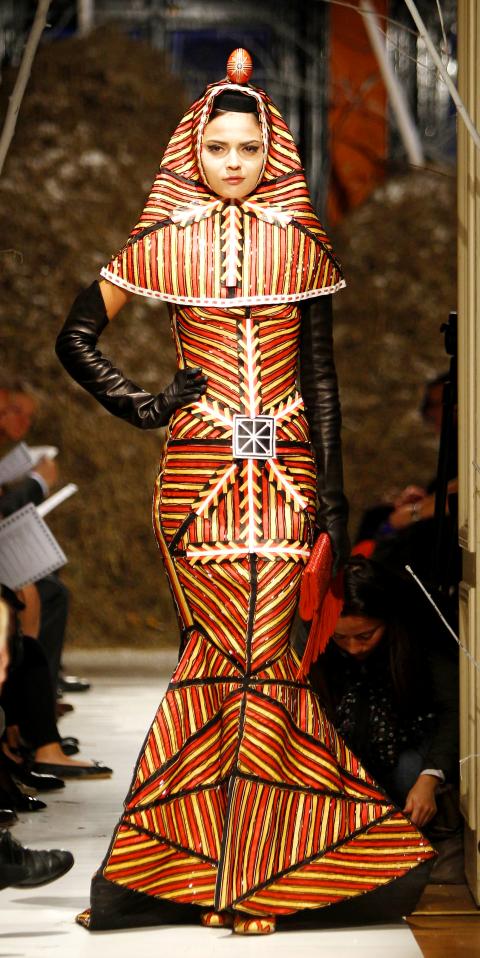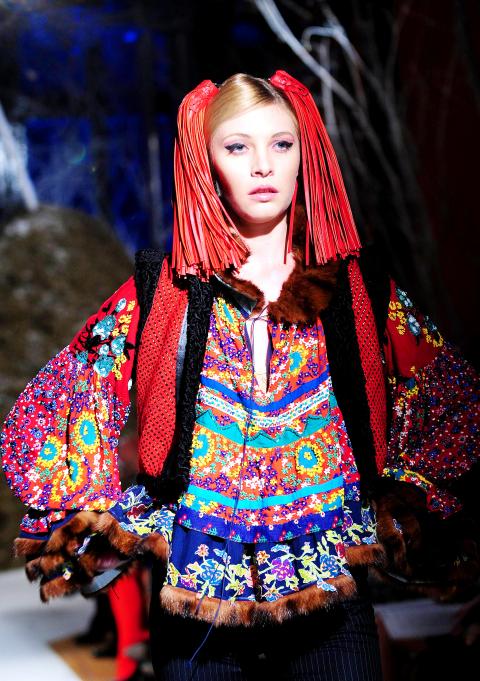Sheepskin skirts with delicate bead embroidery shone on a Bucharest catwalk in a one-of-a-kind ethnic fashion show blending French design and centuries-old Romanian handicraft.
The recent vibrant display was meant to counter some of the negative labels stuck on Romania, often dismissed as a drab post-communist outback, but in fact a rich melting pot of Latin, Balkan, Hungarian, Slav and Roma influences.
Entitled Prejudice, the women’s clothing line created by the French designer Philippe Guilet, who previously worked with Karl Lagerfeld, Thierry Mugler and Jean-Paul Gaultier, is to be shown in Paris early next year.

Photo: Reuters
Delicate lace dresses or multicolored woven skirts recalled the traditional women’s costumes of northern Romania, and they floated over high heels inspired by Romanian-born sculptor Constantin Brancusi’s iconic Endless Column.
“Romania is often derided, but actually this country is quite the opposite of what people might think,” said Guilet, who has spent the past four years here.
The former research director for Jean-Paul Gaultier has launched a cultural project called “100%.RO” that aims to reinterpret Romania’s heritage.

Photo: Reuters
Far from the gray, downtrodden cliches, Guilet found the ornate embroidery of artisans from the northern region of Bistrita Nasaud who have been handing down their skills for generations, adorning clothes, belts or necklaces.
“The beads we use for our traditional embroideries resemble a field full of flowers in springtime,” said Ana Bodescu, one of the women who worked on the collection.
In place of their traditional costumes, the women of the remote village of Salva this time embroidered a toreador-style vest, a long organdy black dress or a tweed-like suit with strings of beaded lace.

Photo: AFP
Some of the items took many months — and several kilograms of beads — to create.
Guilet’s encounters with handicraft makers in their rural environment, where 16th-century woodworking tools and bone needles are still used to embroider sheepskin, have inspired 34 creations.
Each one carries a Romanian woman’s name: Anca, Alina, Ioana.
Some 50 local artisans contributed to the show, set against the elegant backdrop of the French embassy in Bucharest, decorated for the occasion with barren trees and haystacks as if caught in a snowstorm.
Many items bore the imprint of Constantin Juravle, an artisan in his 60s from Straja, a remote village in the northern Bucovina region, whose family has been working sheepskin for generations, following a technique that is a carefully kept secret.
One highlight of the collection was a glittery metal-laced dress created by a family of Roma goldsmiths whose metalworking traditions go back 300 years.
The project “is a combination of modernity and ancestral work,” said Guilet, who made the point that Romania still boasts skills and know-how that designers now struggle to find in France.
To illustrate this coming together of two worlds the artisans, most of whom have seldom left their home village, stepped out on the catwalk next to the models and some of Romania’s best known designers at the end of the show.
“Philippe has come from afar and appreciated the value of our skills. It is extraordinary that he has showcased our work,” said Virginia Linul, one of the artisans from Bistrita Nasaud. “Nobody has done this for us before. Now people can see Romania’s real image, one that you don’t generally see and which is quite beautiful.”

May 26 to June 1 When the Qing Dynasty first took control over many parts of Taiwan in 1684, it roughly continued the Kingdom of Tungning’s administrative borders (see below), setting up one prefecture and three counties. The actual area of control covered today’s Chiayi, Tainan and Kaohsiung. The administrative center was in Taiwan Prefecture, in today’s Tainan. But as Han settlement expanded and due to rebellions and other international incidents, the administrative units became more complex. By the time Taiwan became a province of the Qing in 1887, there were three prefectures, eleven counties, three subprefectures and one directly-administered prefecture, with

It’s an enormous dome of colorful glass, something between the Sistine Chapel and a Marc Chagall fresco. And yet, it’s just a subway station. Formosa Boulevard is the heart of Kaohsiung’s mass transit system. In metro terms, it’s modest: the only transfer station in a network with just two lines. But it’s a landmark nonetheless: a civic space that serves as much more than a point of transit. On a hot Sunday, the corridors and vast halls are filled with a market selling everything from second-hand clothes to toys and house decorations. It’s just one of the many events the station hosts,

Two moves show Taichung Mayor Lu Shiow-yen (盧秀燕) is gunning for Chinese Nationalist Party (KMT) party chair and the 2028 presidential election. Technically, these are not yet “officially” official, but by the rules of Taiwan politics, she is now on the dance floor. Earlier this month Lu confirmed in an interview in Japan’s Nikkei that she was considering running for KMT chair. This is not new news, but according to reports from her camp she previously was still considering the case for and against running. By choosing a respected, international news outlet, she declared it to the world. While the outside world

Through art and storytelling, La Benida Hui empowers children to become environmental heroes, using everything from SpongeBob to microorganisms to reimagine their relationship with nature. “I tell the students that they have superpowers. It needs to be emphasized that their choices can make a difference,” says Hui, an environmental artist and education specialist. For her second year as Badou Elementary’s artist in residence, Hui leads creative lessons on environmental protection, where students reflect on their relationship with nature and transform beach waste into artworks. Standing in lush green hills overlooking the ocean with land extending into the intertidal zone, the school in Keelung